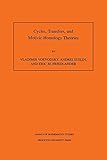Transfers, and Motivic Homology Theories
by Vladimir Voevodsky, Andrei Suslin, and Eric M. Friedlander,
Annals of Mathematics Studies, No. 143,
Princeton University Press, NJ, 254 pages,
ISBN 0-691-04815-0
When thinking about this book, three questions come to mind:
What are motives? What is motivic cohomology?
How does this book fit into these frameworks?
Let me begin with a very brief answer to these questions.
The theory of motives is a branch of algebraic geometry
dealing with algebraic varieties over a fixed field,
k. The basic idea is simple:
enlarge the category of varieties into
one which is abelian, meaning that it
resembles the category of abelian groups:
we should be able to add morphisms, take
kernels and cokernels of maps, etc. The
objects in this enlarged category are to be
called motives, whence the notion of the
motive associated to an algebraic variety.
Any reasonable cohomology theory on
varieties should factor through this category of motives.
Even better, the abelian nature of motives
allows us to do homological algebra.
In particular, we can use extension groups
to form a universal cohomology
theory for varieties. Not only does this
motivate our interest in motives, but the
universal property also gives rise to the
play on words "motivic cohomology".
Different ways of thinking about varieties
leads to different classes of motives
and different aspects of the theory. And
each aspect of the theory quickly leads us
into conjectural territory.
The best understood part of the theory is
the abelian category of pure motives.
This is what we get by restricting our
attention to smooth projective varieties,
identifying numerically equivalent maps and
taking coefficients in the rational numbers
Q. The pure motives of smooth projective
varieties are the analogues of semisimple
modules over a finite-dimensional Q-algebra.
The theory of pure motives is related
to many deep unsolved problems in algebraic
geometry, via what are known as the
standard conjectures.
 At the other extreme, we have the most
general part of the theory of motives,
obtained by considering all varieties and
taking coefficients in the integers Z...
K-Theory Collection
At the other extreme, we have the most
general part of the theory of motives,
obtained by considering all varieties and
taking coefficients in the integers Z...
K-Theory Collection